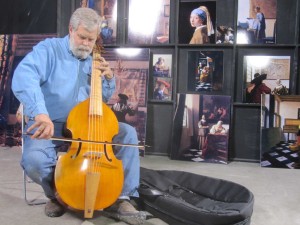
To discuss methods and discoveries presented in the film, a Q&A session immediately followed. Editor Patrick Sheffield and composer Conrad Pope recalled an over five-year collaborative journey through which Tim’s Vermeer was realized.
Sheffield was hired three years before production completion to “pre-digest some of the footage… so the team could view it without having to sit through hours and hours of footage,” Sheffield explained. Finding footage to best support the story meant exploring roughly “55 2Tb hard drives and 2,400 hours of material.”
Consumer level Canon cameras, 4K resolution capable RED cameras and still-photo cameras capture Jenison’s trek through Europe and replication of Vermeer’s famous painted scene: The Music Lesson. Additionally, Jenison shared his findings with producer Farley Ziegler every day via Skype, spanning 130 days of physically demanding investigation. “Every brush stroke is covered by at least three different cameras,” Sheffield said. This allowed for a visual harmony of the painting in progress with “the best of the Skype (sessions).”
Sheffield recalled Teller’s directorial approach as being “open to everybody bringing the maximum of their creativity to it. He would drive the bus and it was up to the rest of us to keep the bus going.” Sheffield added that Teller was clear about what he wanted to achieve but open to the path the team would take to get there.
Teller’s open mind lead to Pope as composer on Tim’s Vermeer after Pope suggested a quirky American approach to the score, contrasting early plans of taking a classical approach. Pope was hired to tell the musical story of Jenison’s adventure once demos of his vision were heard. Pope said, “we keep talking about Vermeer but this seems to be Tim’s story. It needs an American energy. Tim seems like a modern day Thomas Edison to me.”
Regarding the “passion project” nature of the film, Pope recalled the dedication of his musicians despite the long hours they endured. Pope compared Tim’s Vermeer to his other most recent project, The Hobbit: The Desolation of Smaug, saying: “We recorded 63 minutes of music in 10 hours. I just finished conducting The Hobbit, where we recorded three hours of music in somewhere over 100 hours.”
Sheffield and Pope continue their work on Tim’s Vermeer with Sheffield creating DVD extras and Pope working on a soundtrack to accompany the film’s theatrical release by Sony Pictures Classics in 2014.





